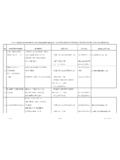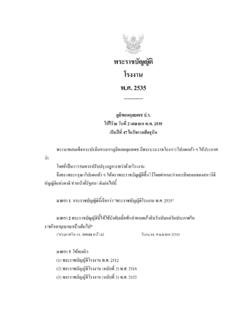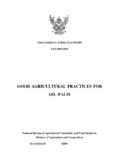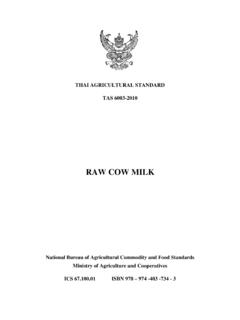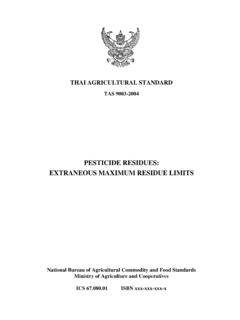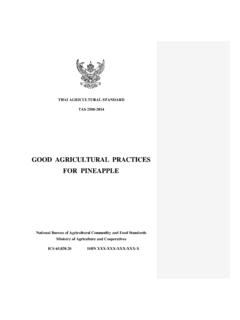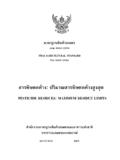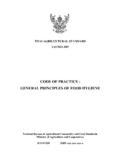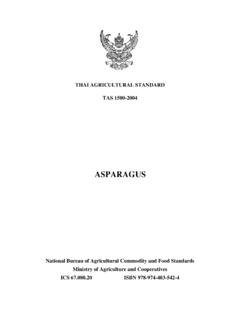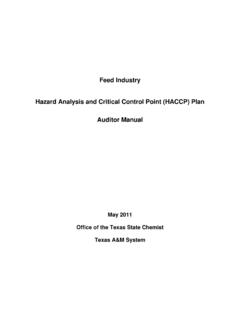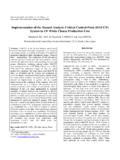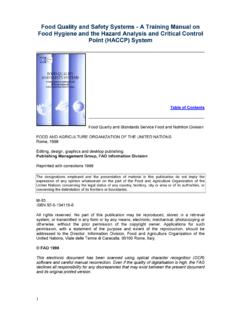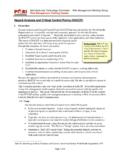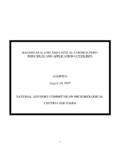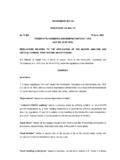Transcription of HAZARD ANALYSIS AND CRITICAL CONTROL POINT …
1 THAI AGRICULTURAL STANDARD TAS 9024-2007 HAZARD ANALYSIS AND CRITICAL CONTROL POINT ( haccp ) system AND GUIDELINES FOR ITS APPLICATION National Bureau of Agricultural Commodity and Food Standards Ministry of Agriculture and Cooperatives ICS ISBN xxx-xxx-xxx-x UNOFFICIAL TRANSLATION THAI AGRICULTURAL STANDARD TAS 9024-2007 HAZARD ANALYSIS AND CRITICAL CONTROL POINT ( haccp ) system AND GUIDELINES FOR ITS APPLICATION National Bureau of Agricultural Commodity and Food Standards Ministry of Agriculture and Cooperatives 50 Phaholyothin Road, Ladyao, Chatuchak, Bangkok 10900 Telephone (662) 561 2277 Published in the Royal Gazette Vol. 125 Special Section 15 D, dated 22 January 2551 (2008) (2)Sub-Committee on the Elaboration for Food Standard 1. Secretary General of the National Bureau of Agricultural Commodity Chairperson and Food Standards Mr.
2 Somchai Charnarongkul, Representative of Secretary General 2. Representative of the Office of Permanent Secretary of Agricultural and Cooperatives Mr. Chuchat Nimsiri 3. Representative of Director General of the Department of Fisheries Mrs. Niracha Wongchinda 4. Representative of Director General of the Department of Livestock Development Mr. Ronachai Juangphanich 5. Representative of Director General of the Department Agriculture Thubthimthai 6. Representative of Secretary General of the Office of the Consumer Protection Board Mrs. Chuensuke Methakulawat 7. Representative of Director General of the Department of Foreign Trade Mr. Kanit Vasiganont 8. Representative of Director General of the Department of Medical Sciences Ms. Piyanart Leevivat 9.
3 Representative of Director General of the Department of Foreign Affairs Mrs. Sarikan Pholmani 10. Representative of Secretary-General of the Food and Drug Administration Mukhajonpun 11. Representative of Director of the National Food Institute Mrs. Orawan Kaewprakaisangkul 12. Representative of Chairman of the Food Processing Industry Club, Federation of Thai Industries Mr. Boonpeng Santiwatanatam 13. Representative of Honor Chairman of the Thai Chamber of Commerce Mrs. Supalak Khemaseth 14. Representative of Honor President of the Thai Food ProcessorsAssociation Mrs. Malinee Subvanich 15. Associate Professor Songsak Srianujata (3) 16. Experts Ms. Amara Vongbuddhapitak Associate Professor Somjit Surapat Mr. Chokechai Aekatasanawan Associate Professor Prasert Saisithi Assistant Professor Mayuree Chaiyawat Mr.
4 Somchai Watanayothin 17. Representative of the Office of Commodity and system Standards, National Bureau of Agricultural Commodity and Food Standards Mrs. Oratai Silapanapaporn Secretary18. Representative of the Office of Commodity and system Standards, National Bureau of Agricultural Commodity and Food Standards Mr. Pisan Pongsapitch Assistant Secretary 19. Representative of the Office of Commodity and system Standards, National Bureau of Agricultural Commodity and Food Standards Kitsukchit Assistant Secretary (4)Food Safety has been an important issue of concern globally. Many measures have been established in order to give confidence to consumers. However, different measures and systems in different countries create problems in international trade. Therefore, the Codex Alimentarius Commission, Joint FAO/WHO Food Standards Programme established the Recommended International Code of Practice: General Principles of Food Hygiene so that each country can adopt to be implemented for the benefit of consumers health and fair trade.
5 This Code of Practice is well accepted internationally. It has been implemented successfully worldwide. Therefore, it is appropriate to establish a national standard that is equivalent to the Codex Code of Practice. The establishment of this standard is based entirely on the following document: FAO/WHO. 2003. Recommended International Code of Practice: General Principles of Food Hygiene; CAC/RCP 1-1969, Rev. 4 (2003), pp. 1-30. In Codex Alimentarius Commission: Food Hygiene Basic Texts, 3rd ed. Joint FAO/WHO Food Standard Programme, FAO, Rome. Remark: The standard title has been revised from Thai Agricultural Commodity and Food Standard (TACFS) to Thai Agricultural Standard (TAS) in accordance with the enforcement of the Agricultural Standards Act 2551 (2008). NOTIFICATION OF THE NATIONAL COMMITTEE ON AGICULTURAL COMMODITY AND FOOD STANDARDS SUBJECT: THAI AGRICULTURAL COMMODITY AND FOOD STANDARD: HAZARD ANALYSIS AND CRITICAL CONTROL POINT ( haccp ) system AND GUIDELINES FOR ITS APPLICATION 2550 (2007) The resolution of the 2/2550 session of the National Committee on Agricultural Commodity and Food Standards dated 28 August 2550 (2007) endorsed the Thai Agricultural Commodity and Food Standard entitled HAZARD ANALYSIS and CRITICAL CONTROL POINT ( haccp ) system and Guidelines for its Application.
6 This Standard would be beneficial as the guidance for authorities and stakeholders to be used for HAZARD ANALYSIS and CRITICAL CONTROL POINT measure throughout the food chain. From this result, food products will be safe and suitable for consumer. By virtue of the Cabinet Resolution on Appointment and Authorization of the National Committee on Agricultural Commodity and Food Standards dated 3 April 2550 (2007), the Notification on Thai Agricultural Commodity and Food Standard entitled HAZARD ANALYSIS and CRITICAL CONTROL POINT ( haccp ) system and Guidelines for its Application is hereby issued as a voluntary standard, the details of which are attached herewith. Notified on 20 September (2007) Professor Teera Sootabuta Minister of Agriculture and Cooperatives Chairperson of the National Committee on Agricultural Commodity and Food Standards TAS 9024-2007 THAI AGRICULTURAL STANDARD HAZARD ANALYSIS AND CRITICAL CONTROL POINT ( haccp ) system AND GUIDELINES FOR ITS APPLICATION INTRODUCTION The first section of this document sets out the principles of the HAZARD ANALYSIS and CRITICAL CONTROL POINT ( haccp ) system adopted by the Codex Alimentarius Commission.
7 The second section provides general guidance for the application of the system while recognizing that the details of application may vary depending on the circumstances of the food The haccp system , which is science based and systematic, identifies specific hazards and measures for their CONTROL to ensure the safety of food. haccp is a tool to assess hazards and establish CONTROL systems that focus on prevention rather than relying mainly on end-product testing. Any haccp system is capable of accommodating change, such as advances in equipment design, processing procedures or technological developments. haccp can be applied throughout the food chain from primary production to final consumption and its implementation should be guided by scientific evidence of risks to human health. As well as enhancing food safety, implementation of haccp can provide other significant benefits.
8 In addition, the application of haccp systems can aid inspection by regulatory authorities and promote international trade by increasing confidence in food safety. The successful application of haccp requires the full commitment and involvement of managementand the work force. It also requires a multidisciplinary approach; this multidisciplinary approach should include, when appropriate, expertise in agronomy, veterinaryhealth, production, microbiology, medicine, public health, food technology, environmental health, chemistry and engineering, accordingto the particular study. The application of haccp is compatible with the implementation of qualitymanagement systems, such as the ISO 9000 series, and is the system of choice in the management of food safety within such systems.
9 While the application of haccp to food safety was considered here, the concept can be applied to other aspects of food quality. Definition (1) CONTROL (verb) means to take all necessary actions to ensure and maintain compliance with criteria established in the haccp plan. 1/The Principles of the haccp system set the basis for the requirements for the application of haccp , while the Guidelines for the Application provide general guidance for practical application. TAS 9024-2007 2(2) CONTROL (noun) means the state wherein correct procedures are being followed and criteria are being met. (3) CONTROL measure means any action and activity that can be used to prevent or eliminate a food safety HAZARD or reduce it to an acceptable level. (4) Corrective action means any action to be taken when the results of monitoring at the CCP indicate a loss of CONTROL .
10 (5) CRITICAL CONTROL POINT (CCP) means a step at which CONTROL can be applied and is essential to prevent or eliminate a food safety HAZARD or reduce it to an acceptable level (6) CRITICAL limit means a criterion which separates acceptability from unacceptability. (7) Deviation means failure to meet a CRITICAL limit. (8) Flow diagram means a systematic representation of the sequence of steps or operations used in the production or manufacture of a particular food item. (9) haccp means a system which identifies, evaluates, and controls hazards which are significant for food safety. (10) haccp plan means a document prepared in accordance with the principles of haccp to ensure CONTROL of hazards which are significant for food safety in the segment of the food chain under consideration. (11) HAZARD means a biological, chemical or physical agent in, or condition of, food with the potential to cause an adverse health effect.
